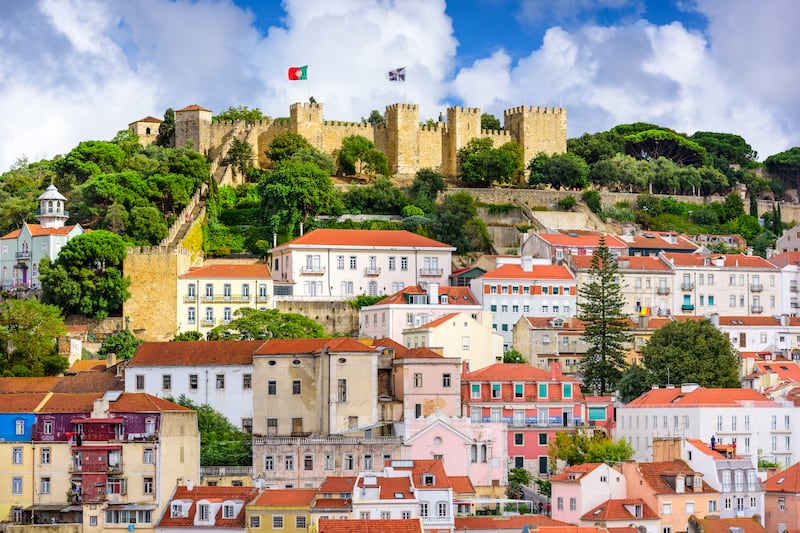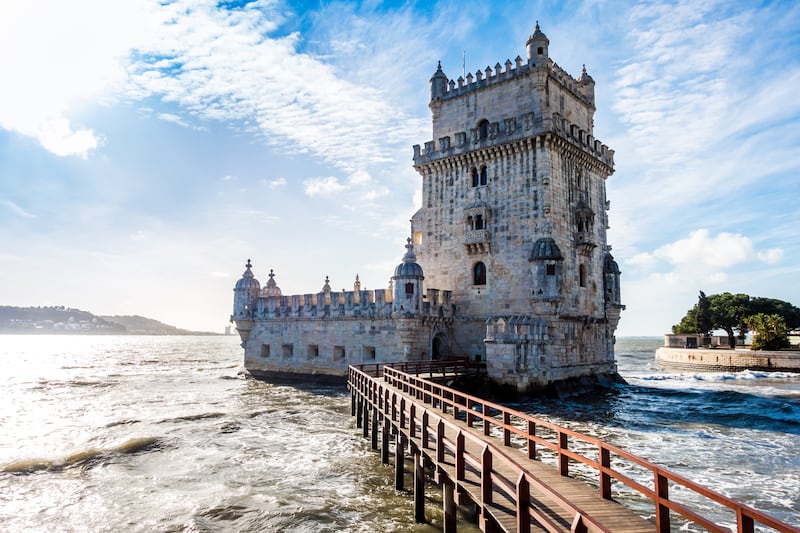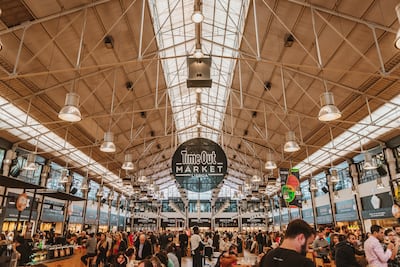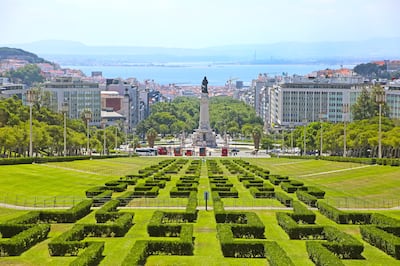The travel guides suggest it takes about three days to find your way around Lisbon, but what they don’t tell you is that once you do you’ll simply want to stay longer.
The capital city of Portugal is built on seven hills on the northern bank of the Tagus river estuary, about 20km from the Atlantic coastline.
On our arrival in May, we climbed up the steps from the metro – which takes about 30 minutes to get from the airport into the city and costs a mere €1.35 – to be greeted by a square filled with beautiful violet flowering trees. These Jacaranda blooms are a feature of many of the intersecting streets that wind through the city centre districts of Baixa (the main shopping area), Chiado (smarter shopping streets and theatres), Mouraria (the area north of the castle), Alfama (the oldest part of town) and Bairro Alto (elevated area buzzing with restaurants and designer shops and magnificent views across the city and the harbour).
Taking a ride on one of Lisbon’s iconic tiny yellow trams is a good way to get a first impression of the landmark features – the fortified Castelo de Sao Jorge; the Sao Bento Palace, seat of the Portuguese parliament and the impressive harbour-facing neoclassical square; Praca do Comercio with its magnificent triumphal arch; Arco de Rua Augusta.
READ MORE
The number 28 tram – dubbed the tourist tram – will take you from the Cemiterio Dos Prazeres in the west right up to Martim Moniz behind the castle in the east. A one-way trip costs €3 if you pay the tram driver and €1.35 if you’ve topped up your city travel card. The number 24 tram is an alternative route but be prepared to be told to get off at the end of each tram line and pay again for your return trip. You can also hire electric scooters to get around or take a guided eco-tuk tour – a fun way for small groups to travel through the narrow streets and winding alleyways of the old city.
Lisbon is bustling with European and American tourists but the locals seem happy to welcome visitors excited to be exploring their decorative city. You can quickly see why many young remote workers also opted to move here from Ireland during Covid-19 for a cheaper lifestyle in a warmer climate.

The Castello de Sao Jorge is one of the must-see sights of Lisbon. Perched up over the city, a walk along the reconstructed ramparts of the castle walls is a relaxing way to take in views right across the Tagus estuary with its magnificent suspension bridge, the Ponte 25 de Abril – renamed after the Carnation Revolution in 1974 when the Portuguese dictator, Antonio de Oliveira Salazar was overthrown.
The gigantic Cristo Rei monument – modelled on the Christ the Redeemer statue in the Brazilian capital, Rio de Janeiro – on the South bank of the river Tagus can also be seen from various points in the city.
If it is your first visit to Lisbon you will be impressed by how the exteriors of many buildings are tiled with glazed painted ceramic tiles (called “azulejos” after the Arabic “azzelij”, meaning polished stones). This tradition, although now mainly done for aesthetic reasons, has its origins in Moorish geometrical mosaics and was used as a way to protect buildings from the city’s humidity. A visit to the Museu Nacional do Azulejo (the National Tile Museum) is an option for those keen to view fine displays of historical and contemporary tiles. Housed in a former 16th century convent on Rua de Madre de Deus, it’s too far to walk from the city centre but takes about 20 minutes on foot from the metro at the Apolonia station.
Another must is a visit to Belém, the harbour where the early Portuguese explorers left from. The large Discoveries monument, built like the prow of a ship, has a line of important historic mariners, royal patrons, cartographers and cosmographers – including Vasco de Gama, the first European to reach India by sea – sculpted into its sides. You can go the top of the monument for views over the city or you can chart the routes taken by these early Portuguese explorers on a large mosaic map, beautifully set into a compass design on the pavement below.
Walk a little further to see the Belém Tower, officially the Tower of Saint Vincent, a 16th century fortification that acts as a ceremonial coastal gateway to the city and the last sight of land for those pioneering explorers from the Age of Discovery.

There are other reasons to visit Belém – the gothic Jeronimos monastery; the original pastry shop, Pasteis de Belém, that has spawned numerous others selling Lisbon’s famous little custard tarts (pastel de nata); and the huge contemporary cultural centre (Centro Cultural de Belém) of Lisbon, completed in 1992. We chose the latter and enjoyed exploring the internal sculptural gardens and courtyards as much as the Berando modern and contemporary art collection within. The LX Factory on Rua Rodrigues de Faria, in Alcantara district, near Belém, offers a selection of offbeat Portuguese arts and crafts, souvenirs, designer shops and galleries, as well as casual eateries in repurposed industrial buildings.
[ A flight-free winter sun holiday through Spain and PortugalOpens in new window ]
Back in the city a stroll along the sea front is a nice visual contrast to walking along the narrow polished stone footpaths. A small beach welcomes sun bathers who can watch the giant cruise ships at dock further west.

There is a dazzling choice of international and local restaurants to choose from. Portuguese chefs have gained a strong reputation for innovative dishes with fish, beef and pork prominent on both tapas-style (petiscos) small plates and main courses.
The Time Out Market inside the Mercado da Ribeira building on Avenida 24 de Julho (Metro stop Cais do Sodre) has food stalls from some of Lisbon’s most popular restaurants in a bustling food court atmosphere. The Argentinian restaurant La Paparrucha in Barrio Alto, with its open air terrace and adjacent glass-fronted restaurant offering magnificent panoramic views across the city, is another option.

Green spaces within the old city are cherished by locals and tourists alike for coffee and beers throughout the day and evening. The Jardim da Estrela, a short walk from our Airbnb, brought us welcome respite on our first day. The Estufa Fria (cold greenhouses) in the largest city park, Parque Eduardo VII (Metro stop Parque or Marques de Pombal), however, left the strongest impression. A large space covered with wooden lath roofing, it is a gardeners’ paradise filled with exotic tree ferns, camellias, banana trees and cacti.
We didn’t make it along to hear Fado, the traditional Portuguese singing accompanied by classical guitar, but made a mental note to return to the Embaixada-Portuguese Concept Gallery on the Praca do Principe Real to catch a performance on our next visit. Neither did we take day trips by train to Sintra to see the Unesco cultural landscape sites at the Palacio Nacional de Sintra or to the highly recommended sandy beach suburb of Cascais.
Just some of the reasons why we’ll return to the Lisbon coast.














